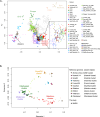Genomic diversity and structure of prehistoric alpine individuals from the Tyrolean Iceman's territory
- PMID: 40645944
- PMCID: PMC12254411
- DOI: 10.1038/s41467-025-61601-8
Genomic diversity and structure of prehistoric alpine individuals from the Tyrolean Iceman's territory
Abstract
The Eastern Italian Alps played a crucial bridging role between Mediterranean and Northern alpine populations since Prehistory. However, few prehistoric individuals from that region have been genomically analysed so far. Among them, the Iceman (Copper Age, 3368-3108 BC) showed a relatively high Anatolian-Neolithic-related ancestry and low Hunter-Gatherers (HGs)-related ancestry. To investigate how the genomic structure of alpine groups varied over time and to contextualize the Iceman, we analysed 47 alpine individuals dated from the Mesolithic (6380-6107 BC) to Middle Bronze Age (1601-1295 BC). The Mesolithic genome reveals genetic admixture between Western and Eastern HGs that occurred from ~13700 - 8300 BC. Most individuals from the Neolithic onwards present a genomic structure resembling that of the Iceman, supporting genetic continuity. Few individuals carry different ancestries, such as the Steppe-related ones appearing ~2400 BC. Finally, the study suggests local and non-local admixture events between HGs and Neolithic farmers from this alpine area.
© 2025. The Author(s).
Conflict of interest statement
Competing interests: The authors declare no competing interests.
Figures




Similar articles
-
Ancient DNA reveals the prehistory of the Uralic and Yeniseian peoples.Nature. 2025 Aug;644(8075):122-132. doi: 10.1038/s41586-025-09189-3. Epub 2025 Jul 2. Nature. 2025. PMID: 40604287 Free PMC article.
-
Genetic Formation of Neolithic Hongshan People and Demic Expansion of Hongshan Culture Inferred From Ancient Human Genomes.Mol Biol Evol. 2025 Jun 4;42(6):msaf139. doi: 10.1093/molbev/msaf139. Mol Biol Evol. 2025. PMID: 40465848 Free PMC article.
-
Ancient genomes from the Yellow River Bend reveal long-distance population interactions between the Central Plains, Steppe, and southern China.Cell Rep. 2025 Aug 26;44(8):116034. doi: 10.1016/j.celrep.2025.116034. Epub 2025 Jul 22. Cell Rep. 2025. PMID: 40705603
-
The Black Book of Psychotropic Dosing and Monitoring.Psychopharmacol Bull. 2024 Jul 8;54(3):8-59. Psychopharmacol Bull. 2024. PMID: 38993656 Free PMC article. Review.
-
[Volume and health outcomes: evidence from systematic reviews and from evaluation of Italian hospital data].Epidemiol Prev. 2013 Mar-Jun;37(2-3 Suppl 2):1-100. Epidemiol Prev. 2013. PMID: 23851286 Italian.
References
-
- Skoglund, P. et al. Origins and genetic legacy of neolithic farmers and hunter-gatherers in Europe. Science (1979)336, 466–469 (2012). - PubMed
Publication types
MeSH terms
Substances
LinkOut - more resources
Full Text Sources

